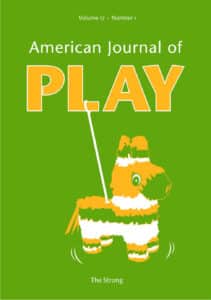ROCHESTER, NY—Media, administrators, and researchers have put a bigger spotlight on teacher well-being and job satisfaction in the years following the classroom disruptions caused by the COVID-19 pandemic. School communities continue to grapple with issues of burnout, stress, and instability in the teaching profession, which can result in negative impacts on student behavior and learning outcomes. In a new article in the American Journal of Play, Celeste M. Dierenfeld, special education teacher and instructional coach, posits that teachers who provide opportunity for students to play—and then engage in play themselves—can lift their spirits and improve their own workplace well-being.

Although it’s been well-established the vital role of play in helping young people to learn and development, Dierenfeld notes that there’s been less research on how play affects teachers. Based on a series of interviews with educators and qualitative data about their play habits, Dierenfeld argues that play aids teacher well-being in three ways. It allows teachers to relax, enhances learning, and helps them to build connections. She writes, “… play acts as a scaffold for teaching and learning, enhancing outcomes with joy and engagement.” All of this serves to lighten the emotional toll on teachers and ease common classroom stressors, such as lack of administrative support.
While play does not erase all the challenges that teachers face, Dierenfeld argues that administrators and districts must put more emphasis on the playfulness of their communities and include play in professional development opportunities. “As researchers and administrators better grasp the power of playful practices in school, more effective training and support can develop teachers who wish to embrace ludic practices in their craft. Playful education can help teachers access joy even in times of stress while simultaneously supporting their effectiveness.”
The complete issue of the American Journal of Play can be read freely online. Additional interviews and articles include:
- Reflections on Video Games and Game History: An Interview with Jesper Juul
- Race, Role Playing, and Simulation Games in the Civil Rights Era: Ghetto, Blacks & Whites, and El Barrio by Chris A. Rasmussen
- The Status of Nature Play in Guyanese Early Childhood Settings by Michelle Semple-McBean, Godryne Wintz, and Lidon Lashley
- Children’s Rights to Play in a Window of Opportunity: Understanding Local Policy Change—Multiple Streams in Bristol (U.K.) Policy Making by Veronica Viñas and Elizabeth Pike
About the American Journal of Play
The American Journal of Play is a peer-reviewed, interdisciplinary publication that serves as a forum for discussing the history, science, and culture of play. Published three times each year by The Strong National Museum of Play in Rochester, New York, the Journal includes articles, interviews, and book reviews written for a broad readership that includes educators, psychologists, play therapists, sociologists, anthropologists, folklorists, historians, museum professionals, toy and game designers, policy makers, and others who consider play for a variety of reasons and from various perspectives.



